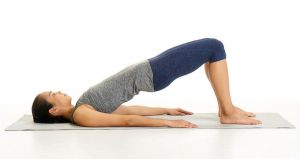Breathing
Breathing for wind instruments and singing modifies the natural breathing movement from a relaxed and unconscious body function to a consciously controlled "music-making movement" for the purpose of sound production. Comparable to bowing technique of the string player, the wind player uses breathing technique for sound production and musical composition.
Contributions by Interviewees
- Michel Arrignon
- Francois Benda
- Paolo Beltramini
- James Campbell
- Alain Damiens
- Eli Eban
- Philippe Cuper
- Gerald Kraxberger
- Sylvie Hue
- Harri Mäki
- Heinrich Mätzener
- Seunghee Lee
- Ernesto Molinari
- Pascal Moraguès
- John Moses
- Thomas Piercy
- Robert Pickup
- Frédéric Rapin
- Milan Rericha
- Ernst Schlader
- Richard Stoltzman
- David Shifrin
- Jérôme Verhaeghe
Historical Treatises
Connection of breathing technique and general posture
It is striking that the subject of breathing technique is not taken up in any of the treatises and "méthodes" of the 18th and 19th centuries. In contrast, the general posture of the body is given great attention. The references to this are usually found in the first chapters of the textbooks.
- Amand Vanderhagen: "Upright but relaxed head position”
- Frédéric Berr: „Head straight, chest in neutral position“
- Jean-Xavier Lefèvre: „Upright position of the head“
- Johann Georg Heinrich Backofen: „The player must stand upright “
- Joseph Fröhlich: „ Keeping the body completely straight“
Interpretation: Here the connection between breathing and the general playing posture becomes evident. If sound is consciously produced in an upright posture, the back muscles are engaged, the spine is straightened, and the chest cannot collapse. If exhalation were forced only by the straight abdominal muscles, the posture could not remain upright and the breath support would be made difficult by the pressure on the diaphragm.
Breathing Technique Today – Contributions by the Interviewees
Interaction of the Inhalation and Exhalation Muscles
The fundamental difference between breathing with a wind instrument and breathing at rest is found in the exhalation. During sound production, an antagonistic interaction of the inhalation and exhalation muscles takes place. To convey this complex technique, the interviewees apply a variety of didactic concepts:
Visual language
Michel Arrignon, Paolo Beltramini, François Benda, Alain Damiens, Eli Eban, Robert Pickup, Thomas Piercy, Frédéric Rapin, Milan Rericha, David Shifrin, Richard Stoltzman, Jérôme Verhaeghe all make use of visual language.
Muscular interaction
Alain Damiens, Heinrich Mätzener, Thomas Piercy, Frédéric Rapin, Milan Rericha describe the concatenation of muscle tensions in airflow and breath support.
Balancing exercises and gymnastics
Balancing exercises or the bridge (yoga) activate the same muscles needed for airflow when playing the clarinet. This is what Alain Damiens, Pascal Moraguès, ]], Ernst Schlader (balance exercises, carriage seat), John Moses (bridge) recommend.
Activating the back muscles
Harri Mäki, Heinrich Mätzener, Jérôme Verhaeghe recommend controlling exhalation from the back.
Full breathing
The following interviewees mention the use of the entire lung volume during inhalation as an important prerequisite for airflow and breath support: François Benda, Eli Eban, Sylvie Hue, Harri Mäki, John Moses, Pascal Moraguès, Thomas Piercy, Milan Rericha, David Shifrin, Jérôme Verhaeghe
Comparisons with vocal technique
Gesangs empfehlen: Eli Eban, Thomas Piercy, Frédéric Rapin recommend study and practice of the breathing technique of singing.
Interactions between breathing, embouchure, and voicing
Alain Billard, Gerald Kraxberger, Seunghee Lee, Robert Pickup, Thomas Piercy, Frédéric Rapin, Ernst Schlader, David Shifrin, Jérôme Verhaeghe, always discuss the exhalation in sound production in connection with embouchure and voicing.
Tuning the lengths of the air columns in instrument and body
The air columns in the instrument and in the body are always coordinated: the lowest tone e resonates with the longest air column, the short b flat1 with the shortest. The airflow adapts accordingly if you play up to the clarinet's cup, or only up to the uppermost open tone hole: Alain Billard, Alain Damiens, Jérôme Verhaeghe.
Below is a sampling from the interviews:
“It feels like drinking air.” This is how Michel Arrignon describes the physical sensation during sound production. It is crucial for the transition between inhalation and exhalation to be seamless, without any sudden resistance in the larynx. Pulling the tip of the tongue back from the reed is enough to set it vibrating.
Paolo Beltramini often observes that students use too much exhalation for too short a period of time, collapsing the sound too quickly. It is necessary to counter the exhalation force with internal tension. The exhalation is then comparable to the direction of a glider pilot flying against the wind and thereby losing altitude more slowly.
François Benda sees the tension phase in the breathing cycle reflected in the sound-producing exhalation. The prerequisite for an efficient breathing technique is comprehensive full breathing. This is guaranteed as a combination of thoracic and diaphragmatic breathing and can be felt with the hands on the back, spine, loins, and abdominal wall. However, this stretching tension must not collapse in on itself, but must be "carried along" into the exhalation phase during sound production. This means that the respiratory muscles (([[Breathing# Respiratory Muscles|diaphragm and external intercostal muscles) remain active; "One is only relaxed at the very moment one inhales."
Alain Billard takes another approach: he always produces exactly as much air pressure with breathing as is required by the musical context and the physical conditions of pitch, register, and dynamics. While the energy of the instrument and the body of the person producing the sound are in balance, there is a neutral area at the point where air enters the instrument, in the embouchure area.
James Campbell: All too often problems arise because we don't think enough about the fact that the clarinet is a wind instrument - it needs air! When we play louder, we need to blow more air into it; when we play more quietly, we need better support. When we fill the lungs, the navel experiences a stretching tension which brings it outwards. That same tension should be maintained during sound production.
Philippe Cuper finds inspiration in playing historical instruments: because they should never be blown with too much pressure, one can transfer the way of playing to modern instruments, playing with less air pressure and working more with the timbres.
Alain Damiens points out first, that the difference between normal breathing and breathing when playing a wind instrument is physically felt during exhalation. During normal inhalation, the lower rib numbers 8 to 11 open and move back to their original position during exhalation. However, the opening of the ribs must remain open when a wind instrument is played for the entire duration of sound production. An easy way to access this technique is to compare it with the cough reflex. Here, the flanks open in a reflex-like manner. During sound production this reflex must play itself out almost in slow motion, slowly and continuously. This can be easily observed by applying light counter-pressure with the hands on the sides. The same feeling of inner muscular tension is experienced when we exhale on one leg while balancing.
Eli Eban took singing lessons and learned the Alexander technique to optimize his breathing technique. He cautions that as soon as one talks about muscle tension in class, such as "the diaphragm remains tense during exhalation," but also "the flanks remain open," there is a great danger of over-tensing the muscles in question. It is sufficient to use a comprehensive full breath for inhalation, and to maintain this internal tension during exhalation and to accompany it with an additional, finely dosed stretching of the thorax in all directions - even in the back. This can be easily felt with the hands. During the transition from the inhalation to the exhalation phase, care must be taken to ensure that the larynx remains free and relaxed. It is equally important to maintain an upright posture: the weight of the clarinet must not cause us to tilt and forward, the instrument must always be guided towards the embouchure.
Sylvie Hue speaks in pictures to teach the younger students a good breathing technique. The body awareness of a child is still developing, so referring to anatomical and physiological connections is not yet as comprehensible as for an adult. To become aware of the stretching tensions of breathing, she uses her hands - with the necessary sensitivity. Pictorial language and comparisons also help to convey breathing techniques. She compares inhaling with filling a bottle from the bottom to the top. She also recommends observing and imitating the breathing of a newborn baby: here, full breathing takes place naturally as a combination of diaphragmatic and thoracic breathing. The learning processes of breathing techniques thus change depending on the students’ age and development.
Gerald Kraxberger makes sure that the chest and abdominal muscles do not become too tense during exhalation. Both would have negative effects on the embouchure.
Seunghee Lee uses an elastic belt to become aware of the supporting tension and to train it: she notes the stretching of the belt during inhalation. During exhalation, the belt must not become loose, i.e. you have to apply some pressure against this belt from the inside. In addition, the air must flow slowly and sparingly so as not to put unnecessary pressure on the neck. The air pressure comes from underneath, from the deeper lying muscles of the trunk (core muscles) and must not be generated in the chest.
tieferliegenden Rumpfmuskulatur
Harri Mäki summarizes: breathing for playing a wind instrument is not something we are born with. The exhalation phase is many times longer than during natural breathing out. Inhalation must be performed in a very short time, while using the entire lung capacity. The shoulders should always stay down. To train full breathing, he demonstrates an exercise without an instrument. During the exhalation he stays "as big as possible" and emphasizes the use of the back muscles.
Heinrich Mätzener describes the oppositional interaction of the inhalation and exhalation muscles. At the same time he emphasizes that the diaphragm must remain as elastic as possible. He finds a natural approach to this technique in the cough reflex, which is familiar to all of us. It requires a great deal of self-control to perform the coughing movement in slow motion, but it leads us directly to a body-compatible way of producing sound on the wind instrument.
Ernesto Molinari prefers the word "appogiare" (Italian for "to lean on") to the term "support" when it comes to explaining the breathing technique. It is important to have a good feeling for the body when playing. This depends largely on the instrument, reed, and mouthpiece. The support does not have to be "made"; the instrument itself offers enough resistance to "lean on."
John Moses lies on his back and demonstrates the "bridge" known as a yoga exercise. If you breathe in and out a few times in this position, you will experience exactly the same body sensation during exhalation that keeps the chest open when the sound is produced. Then the task is to transfer this to the normal playing position.
Pascal Moraguès takes care to really fill the lungs with air when breathing in, as opposed to "inflating" the stomach. If one concentrates on the term "diaphragmatic breathing," it is easy to forget that we breathe with our lungs, not with our stomach. Only during exhalation do the muscles of the lower pelvic girdle play an important role. Since the physiological conditions can be very different from individual to individual, it does not make sense to define universal teaching concepts. Moraguès tries to teach the breathing technique in the simplest possible way. The teacher's task is to support the student in finding a permeable relationship between instrument and body. If a hearty full breath is applied, it is not complicated to draw energy from the exhalation, as there is a specific body sensation that accompanies the exhalation in the process of sound production. Moraguès found yoga exercises very helpful for internalizing this body feeling.
Robert Pickup distinguishes between air pressure and air volume: often too much air is blown through the instrument, which he finds negative in the upper clarinet register; underblowing the notes, not responding well. Pickup demonstrates an exercise: he inhales, lets the air flow out evenly and slowly on a quiet "s". The consonant formation "s" imitates the embouchure pressure. He stands in an upright position, shoulders relaxed, chest wide open without sinking in during the exercise. This indicates that inhalation and exhalation forces are active simultaneously.
Thomas Piercy compares inhalation with a movement that extends horizontally along the shoulders and vertically along the spine. The back is pleasantly stretched without any noticeable tension in the body. One can now, figuratively speaking, sit on this air, while at the same time pushing the air into the clarinet. When the large muscle, the diaphragm, is working properly, it stretches the flanks sideways. If it is not working sufficiently, there is no feeling in the flanks. The small muscles of the lips form the base; the face remains completely relaxed. If this force distribution is correct according to the size of the muscles, we can play without unnecessary tension.
For Frédéric Rapin, the challenge of teaching breathing technique lies in the fact that the airflow is based on a complex interplay of numerous muscles around the thorax. It is small muscle tensions that are active during exhalation and at the same time should allow the diaphragm optimal flexibility. The diaphragm should antagonistically resist the inward movement of the M. Musculus transversus abdominis. However, this interaction of the muscles takes place very subtly, with lively flexibility and without great effort.
Excessive tension in the (rectus abdominis abdominal muscles) often leads to blocking of the diaphragm. If the exhalation forces are used excessively, the air reserve is exhausted early, and it is hardly possible to play longer phrases. Symbolically, however, one should let the air escape rather than pressing it towards the embouchure as with a bicycle pump. Frédéric sees a close relationship between breathing technique and singing. The glottis, however, remains open, and is replaced by the embouchure, mouthpiece, and reed. Here the balance is to be made with the air pressure. Finally, Frédéric uses visual language in teaching to convey the specific body feeling during sound production.
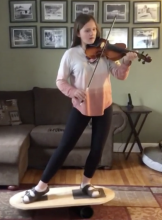
Milan Rericha uses visual language. He compares the air flow with the air exiting a filled balloon. At the beginning the flow speed is low, towards the end the air exits faster. He compares the muscle activations during the breath support with the abdominal press. Important for a good breathing technique is comprehensive full breathing before each tone.
Ernst Schlader starts from the practical side. Without much explanation and without pictorial descriptions he has students stand on a balance board and play the clarinet. In this way they get a natural, balanced body tension. If the shoulders are too high when inhaling, jumping on a trampoline is the best way to relax and prepare for playing the clarinet. Sitting with knees apart and forearms or elbows resting on knees (Coach drivers position) is very effective for learning flank breathing. Playing on related instruments, be it historical clarinets or bass clarinet, is also highly recommended. These instruments sound only without tension, only with adequate – i.e. relatively low – embouchure and air pressure.
David Shifrin is sure that a good, freely vibrating sound quality can only be achieved by leading the air to the mouthpiece at high speed, rather than in large quantities. This is true for every dynamic level. The technique of air conduction is always related to the formation of the embouchure. Here it is important to use tongue position to guide the airflow in an arc to the embouchure area, and there focus it in a small opening (see also Ron Odrich, 2017, 2017).
A garden hose provides useful imagery: with the same water supply, a small opening at the front end can produce a focused, very far-reaching jet; with a wide opening the water only splashes right in front of one's own feet.
An important prerequisite for efficient airflow is to use the lungs to their full capacity before producing sound. David demonstrates the exercise of inhaling in ten steps: if after the fifth breath you already have the feeling that your lungs are full, you can add another five small steps. The point here is to get to know your own lung capacity and the full activity of the inhalation forces and to make use of them. It is just as important to practice very fast inhalations.
Jérôme Verhaeghe teaches breathing techniques using primarily figurative language, but is aware of the anatomical context. One does not breathe "with the belly"; more precise descriptions are needed, and for children, a playful approach at the same time. When lying down, full breathing can be easily "grasped" with one's own hands in the entire thorax, loins, and back. This must be transferred to the upright posture. During exhalation, the air should not escape in one go, in great abundance, but rather, like blowing at a candle to make it flicker evenly without going out. Sounding the various registers requires appropriate voicings: dark vowels are suitable for the low registers; bright ones like i and e for the high ones.
The length of the vibrating column of air in the clarinet has a considerable influence on the air conduction: the column of air in the clarinet is short for b flat' and longest for b'. The column of air in our body must also correspond to these conditions.
Anatomical Introduction
The fundamental difference between resting breathing and breathing when playing a wind instrument lies in the alternation of tension and relaxation: while resting breathing is experienced as an active process and exhalation as relaxing, the opposite is true for sound production. The exhalation produces the sound and therefore powerful. This is followed by the moment of relaxation, in which the air can "fall" into the lungs reflexively and without effort. In vocal technique, this moment is called the "credits" (see Mätzener, 2012[1]). Both inhalation and exhalation can be emphasized with appropriate muscle activations or, as is the case in sports, increases in frequency and effort.
Respiratory Muscles
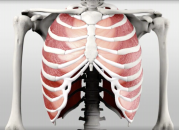
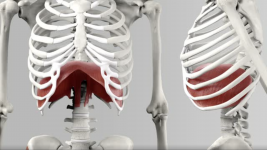
Inhalation is achieved by activating the following muscles:
- The external intercostal muscles (Musculi intercostales externi), which are used for "chest breathing".
- The diaphragm muscle (diaphragm). When this muscle becomes active, it is called "abdominal breathing".
The activation of the respiratory main muscles expands the volume of the thorax, a negative pressure is created and air flows into the lungs. The diaphragm stretches its dome shape downwards during inhalation. This is perceived as a stretching tension in the flanks, abdominal wall, and lumbar region, encompassing the stomach and back. The intercostal muscles lift the ribs and spread the chest. These movements can be felt with the hands. By relaxing these muscles, exhalation follows without any further effort.
Inspiratory Auxiliary Musculature
Auxiliary muscles of chest breathing
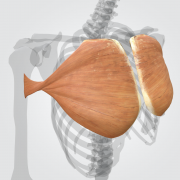
The tensing of the ribs by intercostal muscles (Musculi intercostales externi) can be supported by the auxiliary inspiratory respiratory muscles (Inspiratorische Atemhilfsmuskulatur). The strongest of these are:
The pectoral muscles are primarily used for the movements of both arms. In the case of bilateral fixation (for this purpose, muscles in the back have to be activated at the same time), or when the elbows rest on the knees, they support the lifting of the upper ribs:
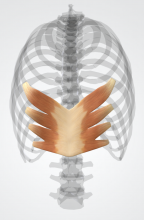
- The chest and back muscles, the anterior serratus muscle and the posterior superior serratus muscle (Musculus serratus anterior and Musculus serratus posterior superior unterstützen ebenfalls die Brustatmung.
), also support thoracic breathing.
- The various strands of the neck muscles (Musculi scaleni) move the head. When tensed on both sides, they lift the upper ribs and widen the chest. Breathing only by expanding the upper ribs is called high breathing.
Auxiliary muscles of abdominal breathing
- The Musculus serratus posterior inferior, which is attached to the spinal column and the lower ribs (see figure left), is another auxiliary muscle. It spreads the lower ribs, widens the flanks, and provides the diaphragm with greater latitude. Its activation can be easily felt in the flanks with thumbs (pointing backwards) and stretched fingers (forwards).
Expiratory Respiratory Muscles
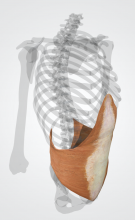
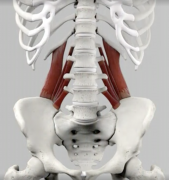
As mentioned above, no muscle tension is necessary for natural exhalation. The following muscles accelerate the exhalation and must be used to produce sound on the wind instrument. Increased air pressure in the embouchure area is required to make the reed vibrate. It is always an interaction of several muscle groups, the most important of which are:
- Musculus latissimus dorsi ("cough muscle")
- Musculus quadratus lumborum (also activated when coughing)
- Musculus transversus abdominis
Other expiratory auxiliary muscles, the lower parts of which can be used in combination:
- Musculus obliquus externus abdominis
- Musculus obliquus internus abdominis
- Musculus transversus thoracis
Similarly, only the lowest parts of the front abdominal muscles ((Musculus rectus abdominis)) should be activated. The entire rectus would harden the abdominal wall and limit the flexibility of the diaphragm. The inner intercostal muscles ((Musculi intercostales interni)) would have been activated immediately upon the application of sound, resulting in too high an exhalation pressure. Only at the end of a long phase of intonation do they come into play. The chest remains open as long as possible during exhalation.
For further information see https://www.physio-pedia.com/Muscles_of_Respiration Physiopedia, Muscles of Respiration]
Breath Support
While the term "breath support" is often used in teaching, it is difficult to find a uniform definition in the teaching literature for clarinet. Balance exercises can replace complicated descriptions and make the muscle tensions involved in breath support physically tangible. Playing on one leg or on a balance board can be helpful exercises ((Alain Damiens, Ernst Schlader), siehe auch "Das antagonistische Zusammenspiel der Ein- und Ausatmungs-Muskulatur". , see also [[Breathing#Interaction of the Inhalation and Exhalation Muscles |Interaction of the Inhalation and Exhalation Muscles]. Balancing and exhaling at the same time automatically activates the desired muscles. It also activates the (Beckenboden pelvic floor), which helps the exhalation to direct the necessary pressure from the bottom to the top. The embouchure creates the resistance necessary for sound production, which can be reduced to the necessary minimum. The resistance at the embouchure forming should never dam the flow of exhaled air. Importantly, all these analyses should not lead to excessive muscle tension in practice; everything should be able to act dynamically and with flexibility, and the energy use should be reflected in the dynamic course of the sound. Easily accessible learning concepts can be found in vocal pedagogy (e.g. Johanna Gutzwiller 1997 [2], Margot Scheufele-Osenberg 1998[3], Marc Flandre 2013 and Singing is a muscular Process). When establishing the "optimal operating pressure" for sound production, inhalation and exhalation muscles are active simultaneously. From this point of view, the antagonistic forces can be described as support (ital. appogio). They produce the correctly measured air pressure and direct it towards the embouchure. Selected clarinetists and vocal pedagogues describe the term as follows:
Marc Flandre
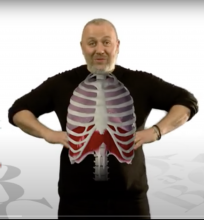
Notice the very visible relaxation at the end of the exhalation phase in Marc Flandre's video. In this moment, all the antagonistic muscles involved in sound production relax and the air is inhaled reflexively without any effort.
Robert Marcellus
„The old business about, as Selmer said, breathing into your stomach – not literally, but figuratively. When I take abreath, it’s very deep and the abdominal stomach wall expands1. It feels pectorally like I’m inflating an inner tube2 or a balloon and the bottom part keeps inflated as one plays. It’s a good feeling; it’s a good, healthy, deep torso kind of feeling about playing. It’s not rigorous at all – quite the contrary3 – but it’s a very deep sustaining kind of support. It just automatically sustains.“
Comments
1 Marcellus recommends costo-abdominal breathing, which is also used in vocal pedagogy and combines chest, flank, and diaphragmatic breathing. It thereby stresses the diaphragmatic respiration. The "belly" is not a breathing organ. The abdominal wall, as well as the loins and back, receive a stretching tension during inhalation through the diaphragm, which is lowered.
2 This description is reminiscent of Frédéric Berr, although he does not comment on anatomical relationships. Berr describes the body sensation during exhalation by depicting the airflow: it is an almost stationary, swinging column of air that moves in a constantly upright posture.
3 This indicates an agile interplay of inhalation and exhalation muscles during the playing of a tone, which can also follow the course of the music. Support is not a static but a dynamic body sensation.
Michael Petzenburg
„Eine weitere wichtige Teilfunktion des Stützvorganges stellt die so genannte Artikulationsstütze dar. Dabei wird die Luft bei offener Glottis gegen die Artikulationsstelle gestützt (Bildung stimmloser Konsonanten). Ein dem Konsonanten nachfolgender Stimmeinsatz lässt sich mit der bereits komprimierten Luft leichter bilden.[21]“
„Another important function of the support process is the so-called articulation support. Here, the air is supported against the articulation site when the glottis is open (formation of unvoiced consonants). Engaging the voice following the consonant can be easier when the air is already compressed.“
Comment Similar to the singing technique, articulation support is produced by tongue and embouchure. For practical implementation, please see also the exercises for [mit Zungenartikulation] (setting-in of the tone with tongue articulation).
H.-J. Schultz-Coulon
„Eine weitere wichtige Teilfunktion des Stützvorganges stellt die so genannte Artikulationsstütze dar. Dabei wird die Luft bei offener Glottis gegen die Artikulationsstelle gestützt (Bildung stimmloser Konsonanten). Ein dem Konsonanten nachfolgender Stimmeinsatz lässt sich mit der bereits komprimierten Luft leichter bilden.[21]“
„Of central importance for the vocalization - especially when singing - is the breath support ("Apoggio"), i.e. the targeted inspiratory counter-activity against the exhalation movement to control the subglottic blowing pressure. Neither the diaphragm nor any other separate muscle group is solely responsible for the breath support. Rather, a subtle interplay of inspiratory and expiratory forces can be demonstrated pneumographically and electrophysiologically during phonation breathing, which depends not only on posture and type of phonation, but also on the condition and fitness of each individual’s voice.“
Comments "Subglottic" can be replaced by "behind the embouchure," referring to the wind instrument. When playing a wind instrument, the glottis is basically open and allows air to flow freely without tension in the vocal cords; the "blowing pressure" only meets the sound producing resistance at the embouchure, mouthpiece, and reed. It is remarkable that in the 18th and 19th centuries "breath support" as an instrumental technical parameter had not yet found its way into instrumental didactics. [[Frédéric Berr#Dosieren der Luft|Frédéric Berr (1831)] describes the amount of air to be exhaled as an important instrumental technical parameter. Instead of breath support, the focus is on the general posture of the body. This indicates that a favorable Spielhaltung, Allgemeine Körperhaltung is combined with sound optimizing exhalation and air flow.
Wolfram Seidner, Jürgen Wendler
„Ziel des Stützvorganges ist die zweckmäßige Führung des Ausatmungsstromes für eine optimale Kehlkopffunktion, wobei die Ausatmung durch ein möglichst langes Beibehalten der Einatmungsstellung verlängert werden soll“
„The aim of the supporting process is to guide the flow of exhalation in a way that optimizes laryngeal function, whereby the exhalation should be prolonged by maintaining the inhalation position as long as possible.“
Comment In this explanation of terms borrowed from Gesangspädagogik (vocal pedagogy, Chapter 3.3. Voice breathing and support process), "optimal larynx function" must be replaced by "optimal embouchure formation."
Fritz Winckel
„[Atem]Stütze ist der Halt, den die Einatmungsmuskulatur dem Zusammensinken des Atembehälters entgegen setzt. Die Stütze dient dazu, den zur Phonation notwendigen subglottischen Druck auf den kritischen Druck (optimaler Betriebsdruck) zu reduzieren.“
„"[Breath] support is the hold that the inhalation muscles provide to prevent the breath container from collapsing. The support serves to reduce the subglottic pressure necessary for phonation to the critical pressure (optimum operating pressure)“
Comment
When playing the clarinet, the optimal operating pressure depends on the reed and mouthpiece, the pressure at the embouchure, and the shape of the oral cavity through the reed and throat. In addition, pitch and dynamics are relevant factors that influence the force and speed of the airflow.
A strong embouchure pressure, for example, requires strong exhalation. Sound - with corresponding characteristics - could therefore be produced without the hold of the inhalation muscles described by Winckel. Conversely, light reeds and low embouchure pressure require greater support.
Higher tones require a faster air flow with constant embouchure pressure; lower tones sound better with slowly guided air. "Supporting" is therefore not a static process, as the term might suggest, but rather a dynamic activity characterized by the constant balancing of the muscular forces of inhalation and exhalation. It makes sense to deal with the individual factors of sound production (e.g. Embouchure, Breathing, und allgemeiner Körperhaltung) in isolation. Ultimately, however, the balance of all forces must always be brought together auditorily, in order to connect them as a whole with the musical event.
Airflow
The term air conduction stands for the intentionally amplified and thus sound producing exhalation activity of a wind instrument or vocals. The air conduction is in constant interaction with the instrumental technical parameters such as
The dynamic course of the musical composition determines the power and agility of the airflow.
An important aspect of air conduction on a wind instrument is the different speed at which the air hits the sound generator: for lower notes the air flows more slowly and has a higher pressure, for higher notes a faster air flow should be created directly before the embouchure opening. Sylvie Hue describes the quality of the air flow as "warm" or "cold air." Basically, she recommends creating a "cold" air flow regardless of the embouchure shape. This can be tested simply by exhaling with the hand in front of the embouchure. The airflow is modified in particular by the position and shape of the tip of the tongue, which can "get in the way" of the air or allow it to move freely.
Historical Sources
Literature
- Heinrich Mätzener, Johanna Gutzwiller, Beate Sick, Hans-Christoph Maier, Laura Tomatis: Klarinettenklang, Versuch einer physiologischen Analyse, Forschungsbericht der Hochschule Luzern–Musik. Luzern 2012 [2] eingesehen am 15. Mai 2015
- Margot Scheufele-Osenberg: Die Atemschule: Übungsprogramm für Sänger, Instrumentalisten und Schauspieler; Atmung, Haltung, Stimmstütze Studienbuch Musik. Mainz, Schott 1998.
- Martin Vacha: Das Fach Gesang als Brennpunkt universitärer SängerInnenausbildung. Eine programmatische Darstellung. Wien 2013 [3] eingesehen am 15. Mai 2015]
References
- ↑ Mätzener, Heinrich. 2012. Klarinettenklang Versuch einer physiologischen Analyse. Luzern: Hochschule Luzern - Musik, S.31 [4]
- ↑ Gutzwiller, Johanna 1997. Körperklang - Klangkörper: ein Arbeitsbuch über Körperarbeit für Chorleiter, Sänger und Instrumentalisten. Musiked. Nepomuk, 1997
- ↑ Scheufele-Osenberg, Margot 1998. Die Atemschule. Übungsprogramm für Sänger, Instrumentalisten und Sprecher / Atmung - Haltung - Stütze. Schott. Mainz, Tokyo 1998.
- ↑ James Gholson: Interviewe with Robert Marcellus. In: Australian clarinet and Saxophone, March 1999 [5]
- ↑ Michael Petzenburg: Stimmbildung, Wissenschaftliche Grundlagen – Didaktik – Methodik. Wißner, Augsburg 2007, Seite 34. zitiert aus Wikipedia, Gesankgspädagogik eingesehen am 15. Mai 2015
- ↑ Michael Petzenburg: Stimmbildung, Wissenschaftliche Grundlagen – Didaktik – Methodik. Wißner, Augsburg 2007, Seite 34. zitiert aus Wikipedia, Gesankgspädagogik eingesehen am 15. Mai 2015
- ↑ Wolfram Seidner, Jürgen Wendler: Die Sängerstimme. Henschel, Berlin 1997, Seite 63. zizitert aus Wikipedia, Gesankgspädagogik eingesehen am 15. Mai 2015
- ↑ Fritz Winckel in: Wissenschaftliche Zeitschrift der Friedrich-Schiller-Universität, Gesellschafts- und sprachwissenschaftliche Reihe Band 7, Jena 1957, Seite 489. zitiert aus Wikipedia, Atemstütze, eingesehen am 15. Mai 2015


